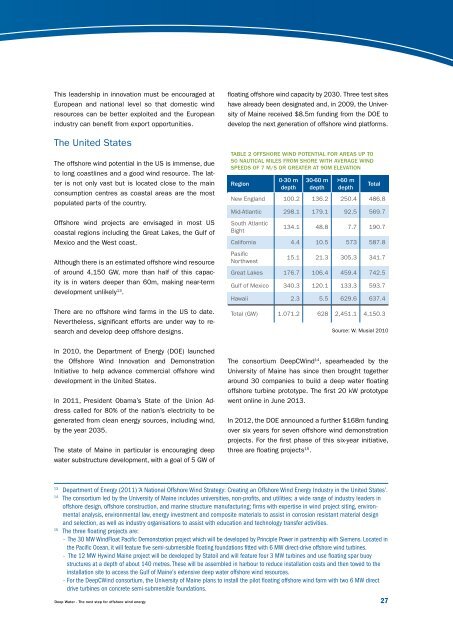Deep_Water
Deep_Water
Deep_Water
Create successful ePaper yourself
Turn your PDF publications into a flip-book with our unique Google optimized e-Paper software.
This leadership in innovation must be encouraged at<br />
European and national level so that domestic wind<br />
resources can be better exploited and the European<br />
industry can benefit from export opportunities.<br />
The United States<br />
The offshore wind potential in the US is immense, due<br />
to long coastlines and a good wind resource. The latter<br />
is not only vast but is located close to the main<br />
consumption centres as coastal areas are the most<br />
populated parts of the country.<br />
Offshore wind projects are envisaged in most US<br />
coastal regions including the Great Lakes, the Gulf of<br />
Mexico and the West coast.<br />
Although there is an estimated offshore wind resource<br />
of around 4,150 GW, more than half of this capacity<br />
is in waters deeper than 60m, making near-term<br />
development unlikely 13 .<br />
There are no offshore wind farms in the US to date.<br />
Nevertheless, significant efforts are under way to research<br />
and develop deep offshore designs.<br />
floating offshore wind capacity by 2030. Three test sites<br />
have already been designated and, in 2009, the University<br />
of Maine received $8.5m funding from the DOE to<br />
develop the next generation of offshore wind platforms.<br />
Table 2 Offshore wind potential for areas up to<br />
50 nautical miles from shore with average wind<br />
speeds of 7 m/s or greater at 90m elevation<br />
Region<br />
0-30 m<br />
depth<br />
30-60 m<br />
depth<br />
>60 m<br />
depth<br />
Total<br />
New England 100.2 136.2 250.4 486.8<br />
Mid-Atlantic 298.1 179.1 92.5 569.7<br />
South Atlantic<br />
Bight<br />
134.1 48.8 7.7 190.7<br />
California 4.4 10.5 573 587.8<br />
Pasific<br />
Northwest<br />
15.1 21.3 305.3 341.7<br />
Great Lakes 176.7 106.4 459.4 742.5<br />
Gulf of Mexico 340.3 120.1 133.3 593.7<br />
Hawaii 2.3 5.5 629.6 637.4<br />
Total (GW) 1.071.2 628 2,451.1 4,150.3<br />
Source: W. Musial 2010<br />
In 2010, the Department of Energy (DOE) launched<br />
the Offshore Wind Innovation and Demonstration<br />
Initiative to help advance commercial offshore wind<br />
development in the United States.<br />
In 2011, President Obama’s State of the Union Address<br />
called for 80% of the nation’s electricity to be<br />
generated from clean energy sources, including wind,<br />
by the year 2035.<br />
The state of Maine in particular is encouraging deep<br />
water substructure development, with a goal of 5 GW of<br />
The consortium <strong>Deep</strong>CWind 14 , spearheaded by the<br />
University of Maine has since then brought together<br />
around 30 companies to build a deep water floating<br />
offshore turbine prototype. The first 20 kW prototype<br />
went online in June 2013.<br />
In 2012, the DOE announced a further $168m funding<br />
over six years for seven offshore wind demonstration<br />
projects. For the first phase of this six-year initiative,<br />
three are floating projects 15 .<br />
13<br />
Department of Energy (2011) ‘A National Offshore Wind Strategy: Creating an Offshore Wind Energy Industry in the United States’.<br />
14<br />
The consortium led by the University of Maine includes universities, non-profits, and utilities; a wide range of industry leaders in<br />
offshore design, offshore construction, and marine structure manufacturing; firms with expertise in wind project siting, environmental<br />
analysis, environmental law, energy investment and composite materials to assist in corrosion resistant material design<br />
and selection, as well as industry organisations to assist with education and technology transfer activities.<br />
15<br />
The three floating projects are:<br />
- The 30 MW WindFloat Pacific Demonstration project which will be developed by Principle Power in partnership with Siemens. Located in<br />
the Pacific Ocean, it will feature five semi-submersible floating foundations fitted with 6 MW direct-drive offshore wind turbines.<br />
- The 12 MW Hywind Maine project will be developed by Statoil and will feature four 3 MW turbines and use floating spar buoy<br />
structures at a depth of about 140 metres. These will be assembled in harbour to reduce installation costs and then towed to the<br />
installation site to access the Gulf of Maine's extensive deep water offshore wind resources.<br />
- For the <strong>Deep</strong>CWind consortium, the University of Maine plans to install the pilot floating offshore wind farm with two 6 MW direct<br />
drive turbines on concrete semi-submersible foundations.<br />
<strong>Deep</strong> <strong>Water</strong> - The next step for offshore wind energy 27


